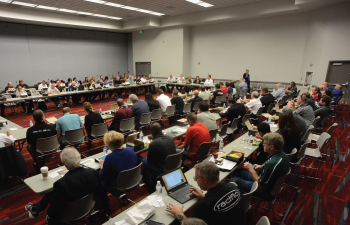SEMA News - July 2009
Factors to Consider Include Price, Transport Costs, Tariffs and More
 | |
| A U.S. company exporting exhaust mufflers to Australia can benefit from zero tariff rates due to a free trade agreement between the United States and Australia. As there is currently no such agreement with Brazil, exports of the same products would be charged a duty rate of 18% to sell the products into that market. Photo Courtesy of ACP |
|
Selling products to overseas markets is an important opportunity often overlooked by manufacturers seeking newcustomers to help weather the economic storm. In the first three months of this year, more than $17.2 billion was generated in overseas sales of U.S. automotive vehicles, parts and engines. Moreover, selling products overseas is not all that different from selling to U.S. customers if the fundamentals are there—a good product at a good price.
There are a number of factors to be considered in identifying the best potential overseas markets, such as identifying any government restrictions on the use of the product; whether local consumers have sufficient disposable income (the ability of consumers to buy discretionary products); and whether the products fit the vehicles on the road in that market. SEMA has the resources to assist members, including information on top-selling vehicles, most accessorized vehicles and up-to-date information on laws. It’s all available online on the SEMA International homepage.
In developing a marketing plan, companies need to assess whether a product is price-competitive. Factors affecting this aspect include the costs to transport your products worldwide—deciding between ocean, freight or air, for example. Other added costs to be factored into determining the wholesale price of the product are any import fees (also referred to as duties or tariffs) charged by overseas governments. These government-imposed fees are product- and country-specific and can vary greatly. Rates are lowest for countries with which the United States has free trade agreements, such as Australia and Canada. They are higher—sometimes significantly—for those countries with which no similar pact exists. Taking this to the product level, a U.S. company exporting exhaust mufflers to Brazil, for instance, would be charged a duty rate of 18%, but those same exhaust mufflers exported to Australia or Canada would not incur any duties or import fees, thus greatly impacting costs.
In the past few years, the process of identifying import fees when exporting has been streamlined by the international adaptation of the Harmonized System. Virtually every country utilizes the same six-digit sequence to every product, known as the harmonized code. For products exported from the United States, this number sequence is also referred to as the Schedule B number.
 |
|
| In developing a marketing plan, companies need to assess whether the product is priced competitively for local consumers. Factors affecting this aspect include the costs to transport products worldwide. Other added costs to be factored into determining the wholesale price of products are any import fees (also referred to as duties or tariffs) charged by overseas governments. |
|
Once you have selected the correct Schedule B number, companies can utilize a second free online website. Companies can search by country to identify the proper tariff rates. The software automatically calculates the rate of duty for each Schedule B number. It also provides you with the applicable taxes and country notes.
Closer to home, the SEMA Show is undoubtedly the best place to network with international buyers. This year, SEMA exhibitors can take advantage of a powerful new online program to develop contacts with thousands of international buyers from more than 100 countries seeking new products. Buyers and exhibitors can contact each other and begin communications even before arriving in Las Vegas and arranging meetings during Show week. All international buyers and SEMA exhibitors seeking global business should avail themselves of the Center for International Commerce—a centrally located facility with private meeting rooms and complimentary interpretation services. For more information on how to develop your international business at the 2009 SEMA Show, contact Linda Spencer.
For more information on SEMA’s international resources, go to the SEMA International homepage or contact Stacie Hering.
The listing below is a highlight of selected SEMA online resources.
SEMA’s Online Resources








